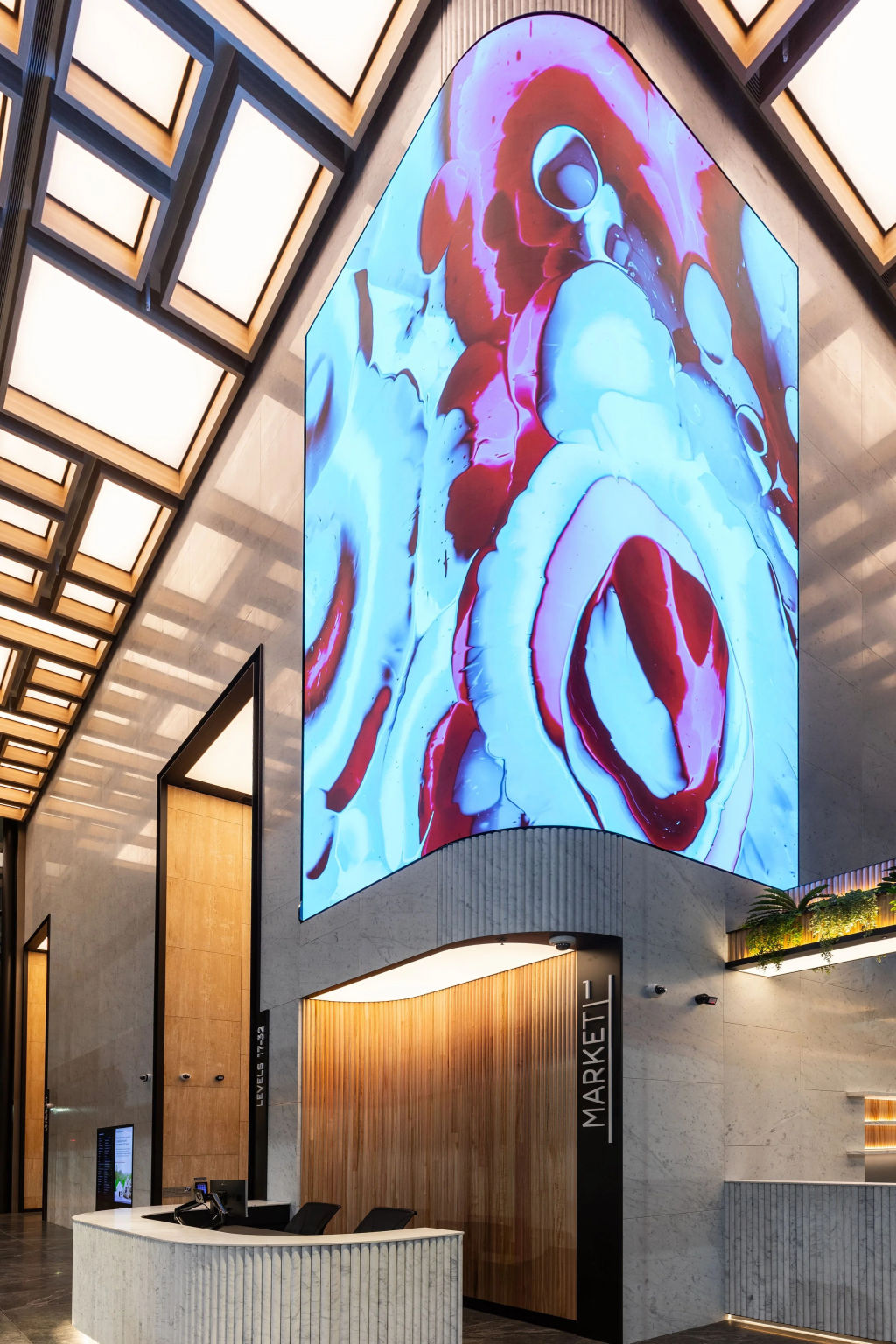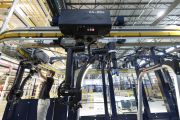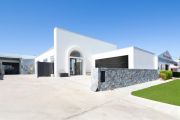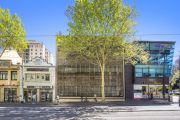
The power of art to transform corporate offices
A massive, 12-metre-high video wall anchors the main thoroughfare of the award-winning, $1.5 billion Dexus building in Melbourne. It captivates visitors with a continuous flow of digital art that shifts between vibrant nature-inspired compositions, like abstract waves and organic liquids, to kinetic patterns in cool tones of blue, purple and pink.
Inspired by the theme Scale in Nature, its curator Art Pharmacy says the work asks the daily traffic of employees, visitors and passersby to: “Pause, look up and be awestruck by the immensity of your environment … to rise above the hustle and bustle of the city and explore a vibrant and unique world.”
The experiential artwork is proof that the days of the hushed, monochrome corporate office are long gone. In its place, businesses are utilising their vast spaces to create galleries and art installations that tell the story of their company through the lens of contemporary art.
Many major Australian corporations, including Wesfarmers, Macquarie Group and Deloitte, have curated collections that reflect the diversity of Australia’s landscape and culture. These art collections are not just a reflection of the business and its values, but an important part of the company’s work in the social impact space, supporting emerging artists across the country, as well as a way to spark conversation and art appreciation among employees.
Art Pharmacy founder Emilya Colliver works with major corporations to transform their business premises into workspaces that reflect their values and connect with their employees and communities. Among her clients are Deloitte, CBRE, Mirvac, Charter Hall and Uber.
“Central to a brief is curating works that will transform a space and leave a lasting impression,” says Colliver. “But, in the corporate space, there’s often a strong preference for works that feel uplifting, textural, and in harmony with a company’s brand identity or spatial design.”
Deloitte, one of Australia’s Big Four accounting and professional service firms, has worked with the art consultancy to transform four capital city headquarters.
Deloitte principal and head of workplace and group property, Robyn De Szoeke OAM, says that while each art collection reflects the company’s core values of diversity and positive impact on community, they also tell a story about the unique character of their home city.
Visit the vibrant, conversation-starting art collection at Deloitte’s Quay Quarter Tower in Sydney’s Circular Quay, and it’s easy to see how it reflects the company’s vision of sustainability and sense of place.
Themed Regeneration, 60 per cent of the building materials were upcycled and the artworks were created by a mix of emerging and established Sydney artists, with 33 per cent from First Nations and 24 per cent from culturally diverse backgrounds.
The art collection delivers a “purposeful kaleidoscope of different ideas, textures and mediums created by a diverse community of talented artists and storytellers.”
In Adelaide, the narrative took a lighter turn as Deloitte employees were keen to see their new workplace and the art within its walls reflect its place in a festival city.
It also celebrated First Nations’ artists with 45 per cent of the work produced by Indigenous artists who reflected on their spiritual connection to local cultural sites.
“Sustainability and sense of place are consistent themes that come through from our people,” De Szoeke explains.
“We always ask what is important to them in their city, or in their location. We invite them to workshops and perhaps do a short survey, and from that, we will then develop the themes or narratives that are important to our people.
“In Adelaide it was about joy, the fun of a festival city – our people felt upbeat and wanted to showcase the best of what their city had to offer.”
As employers continue to struggle to lure people back to city offices post the pandemic, Colliver says interactive art and more home-like interior design can make a difference.
She encourages corporate clients to consider ways they can create more feminine spaces that exude a sense of wellbeing, bring nature indoors, and utilise digital art that makes workspaces more engaging.
“The great thing about digital art is that you can change the content really quickly. At a flick of a switch you can celebrate Diwali, the festival of light, NAIDOC week, the spring racing carnival or Chinese New Year,” she says.
Colliver quotes the transformation of Investa’s corporate lobby – through the creation of a “living, breathing artwork” – as a testament to the power of digital art to connect with people.
“It’s those moments, when art shifts the energy of a place and changes how people move through it … watching people look up and truly engage with the space was incredibly moving,” she says.










